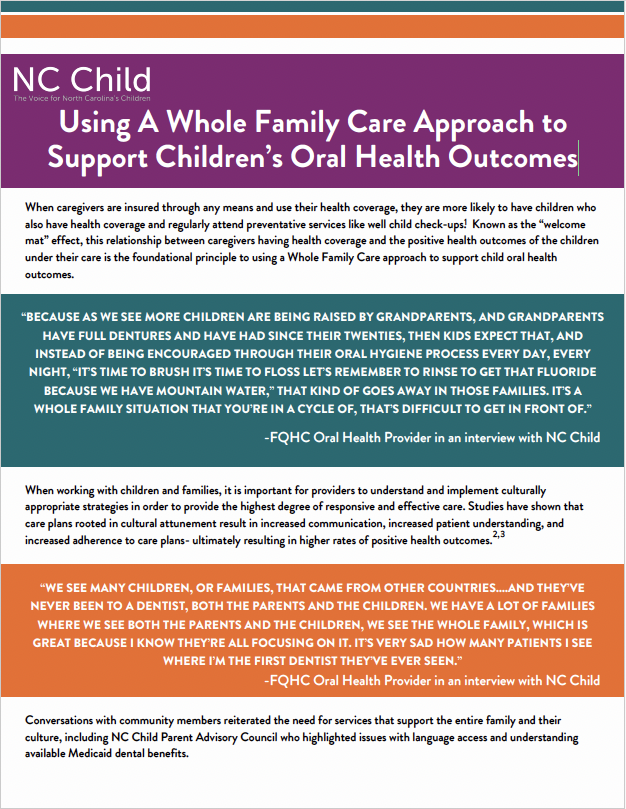When caregivers are insured through any means and use their health coverage, they are more likely to have children who also have health coverage and regularly attend preventative services like well child check-ups (1). Known as the “welcome mat” effect, this relationship between caregivers having health coverage and the positive health outcomes of the children under their care is the foundational principle to using a Whole Family Care approach to support child oral health outcomes.
“Because as we see more children are being raised by grandparents, and grandparents have full dentures and have had since their twenties, then kids expect that, and instead of being encouraged through their oral hygiene process every day, every night, “it’s time to brush it’s time to floss let’s remember to rinse to get that fluoride because we have mountain water,” that kind of goes away in those families. It’s a whole family situation that you’re in a cycle of, that’s difficult to get in front of.” -FQHC Oral Health Provider in an interview with NC Child
When working with children and families, it is important for providers to understand and implement culturally appropriate strategies in order to provide the highest degree of responsive and effective care. Studies have shown that care plans rooted in cultural attunement result in increased communication, increased patient understanding, and increased adherence to care plans- ultimately resulting in higher rates of positive health outcomes (2,3).
“We see many children, or families, that came from other countries….and they’ve never been to a dentist, both the parents and the children. We have a lot of families where we see both the parents and the children, we see the whole family, which is great because I know they’re all focusing on it. It’s very sad how many patients I see where I’m the first dentist they’ve ever seen.” -FQHC Oral Health Provider in an interview with NC Child
Conversations with community members reiterated the need for services that su port the entire family and their culture, including NC Child Parent Advisory Council who highlighted issues with language access and understanding available Medicaid dental benefits.
According to the most recently available NC DHHS oral health data, there are significant differences by race and ethnicity in who gets access to dental health care. Two-thirds of white children enrolled in Medicaid received at least one oral health service in 2019, compared to just over half of Black and American Indian children, for example (4).
Key Recommendations
Take a family unit approach to dental services under Medicaid
- Policy Recommendation: Include dental homes as part of care management/coordination teams to help ensure that all Medicaid members have access to a dentist and can utilize care.
- Policy Recommendations: Support a braided funding approach that incentivizes clinics and public health departments to see entire families in the same visit to reduce family burden and increase supportive practices.
- Policy Recommendation: Increase the use of community and mobile clinics under Medicaid.
Ensure that culturally appropriate care is central to oral health service delivery in Medicaid
- Policy Recommendation: Create CPT code for patient-centered care for dental services.
- Policy Recommendation: Increase utilization of Community Health Workers supporting oral health.
- Policy Recommendation: Strengthen state requirements to provide access to timely and appropriate medical interpretation services in all FQHCs and Departments of Public Health.
Endnotes
1 “Medicaid Expansion For Adults Had Measurable ‘Welcome Mat’ Effects On Their Children,” J Hudson, A Moriya, Health Affairs, September 2017. http://content.healthaffairs.org/content/36/9/1643.abstract
2 Brach, C. & Fraser, I. 2000. Can cultural competency reduce racial and ethnic health disparities? A review and conceptual model. Medical Care Research and Review, 57 (Supplement 1), 181-217.
3 Nair L, Adetayo OA. Cultural Competence and Ethnic Diversity in Healthcare. Plast Reconstr Surg Glob Open. 2019 May 16;7(5):e2219. doi: 10.1097/GOX.0000000000002219. PMID: 31333951; PMCID: PMC6571328. https://www.ncbi.nlm.nih.gov/pmc/articles/PMC6571328/
4 NC Child. (2021, October). NC Child Tooth Dismay: New look at the Data Children’s Oral Health … NC Child. https://ncchild.org/wp-content/uploads/2021/10/NCC-OralHealth-summary.pdf

